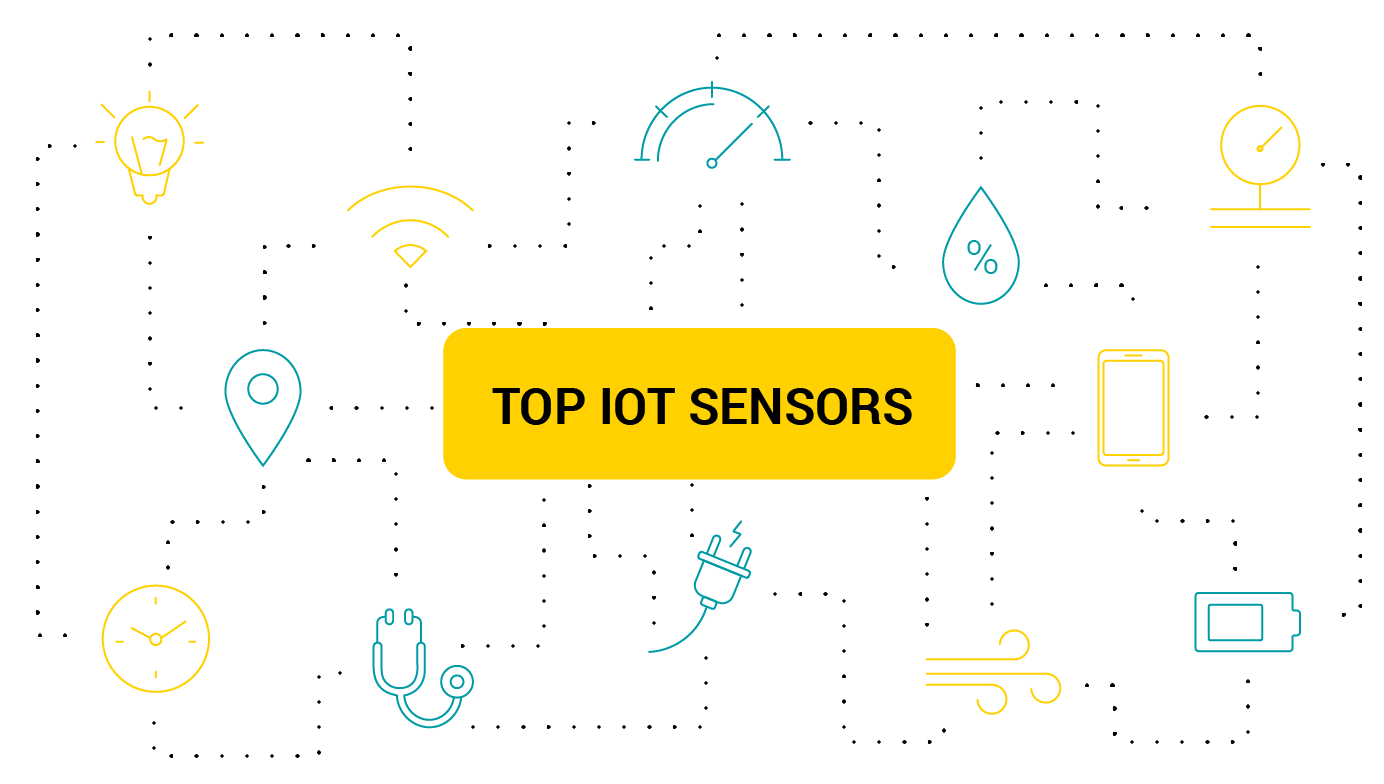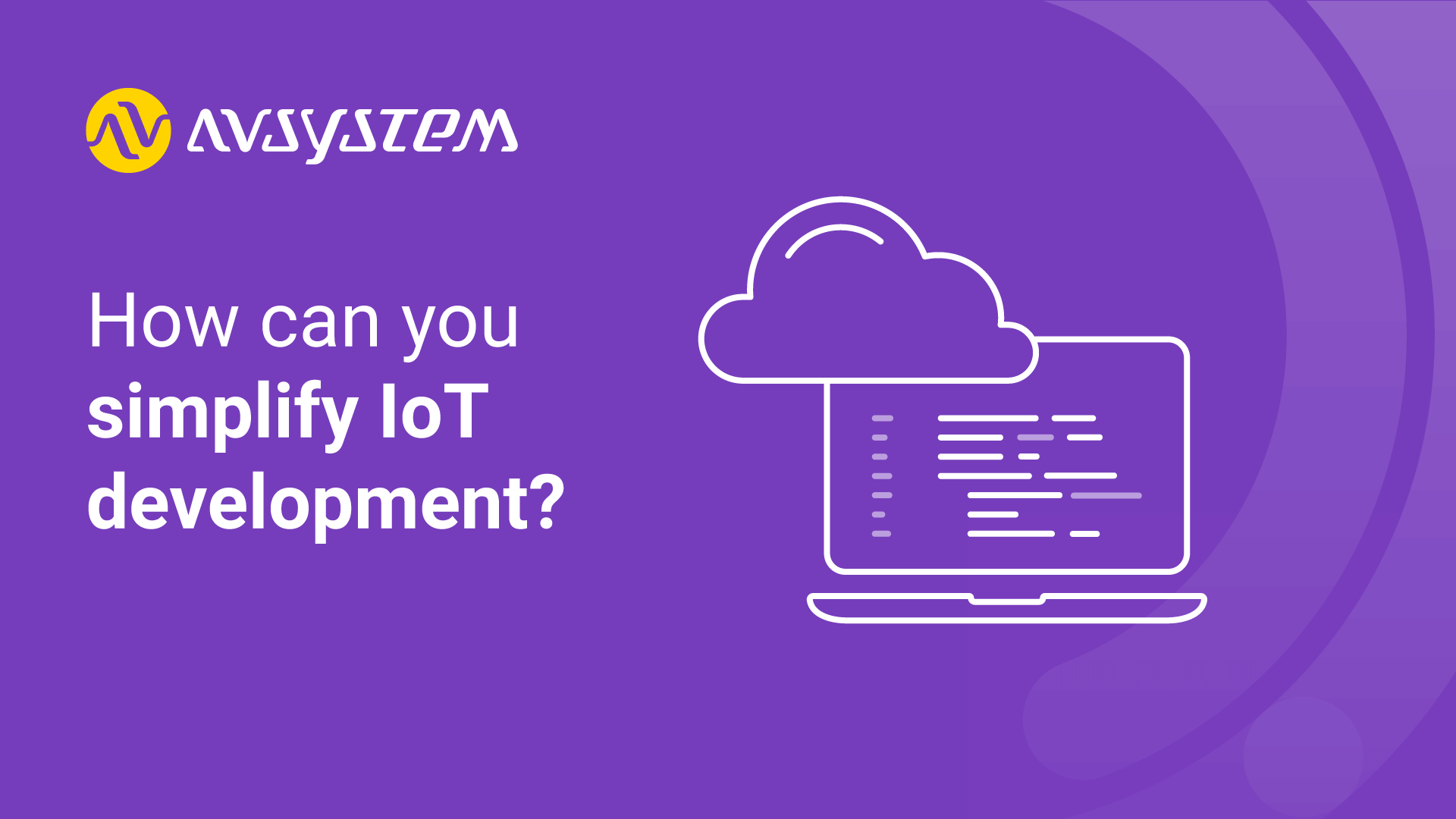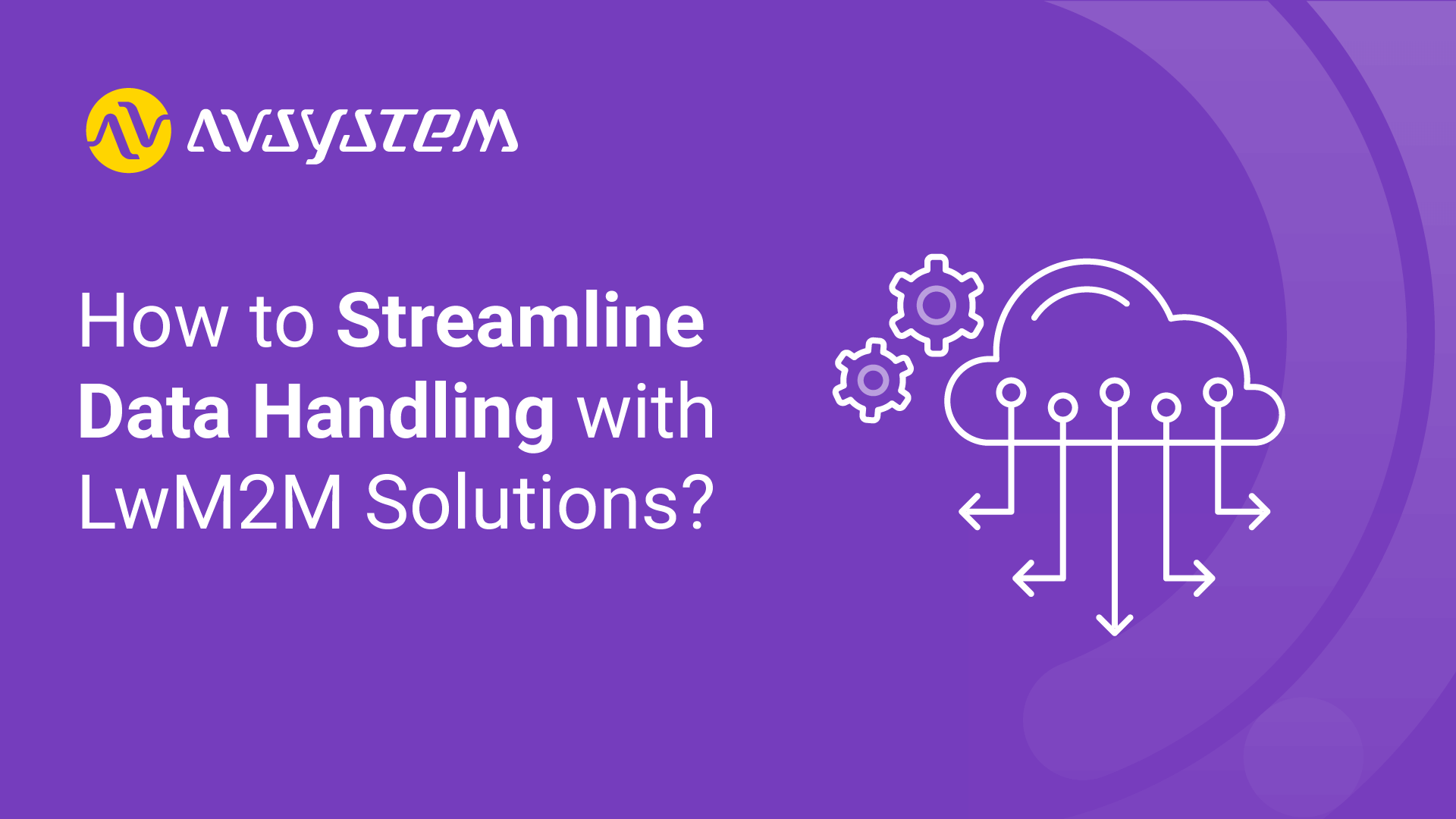Top sensor types used in IoT

IoT, the hottest tech buzzword of the last years, is all about collecting, sharing and analysing data and creating value from it. But without accurate data, IoT would become a useless heap of technology. Hence, the importance of IoT device management and IoT sensors and actuators which enable it to sense the world and act upon it.
Making sense of IoT sensors and actuators
IoT is composed of several technology layers (Technology Behind Internet of Things) which enable ordinary things to share the data they collect over the Internet to ultimately deliver intelligence, autonomous actions and value which largely depend on the quality of the data itself. Therefore, sensors and actuators are an indispensable part of the IoT tech stack and a make-or-break factor in the development of every IoT system.
Obviously, sensors and actuators are important to IoT, but what are they after all? A sensor, also called a transducer, is a device whose task is to detect events or changes in its immediate environment and convert these physical phenomena (like temperature, light, air humidity, movement, presence of chemical substances and many others) into electrical impulses which then can be meaningfully interpreted. An actuator, on the other hand, can be seen as a tool which functions inversely to the sensor. By interpreting the electrical impulses sent from the control system and converting them into mechanical motion, it actually introduces changes to its physical surroundings by means of a variety of simple actions, including but not limited to opening and closing valves, changing other devices’ position or angle, activating them or emitting sounds or light. In simpler terms, the actuator is referred to as a ‘mover’.
While ordinary electrical sensors and actuators have been around for decades and are omnipresent in the modern industrial applications, the emergence of the Internet of Things has opened up completely new possibilities of IoT sensor and actuator application not only within the industrial sector, but also in the field of commercial and domestic use. As indispensable enablers of IoT, sensors and actuators help monitor, control, and streamline operations in almost every kind of sector, from smart vehicles to rainforest protection. Revolutionising the way they are applied and expanding the extent to which they are employed, the Internet of Things has put sensors to work for powerful, cloud-based analytical software to develop intelligent solutions for machines, people and environment alike.

Taking all the above into account, there can be no doubt that in order to maintain the fast-paced evolution it has been experiencing, the Internet of Things needs increasingly more efficient (and preferably low-cost) sensor solution. A reliable sensor and actuator system is the basis on which every successful smart deployment is built, therefore it is imperative to be aware of the kinds of IoT sensor solutions and options that are out there. Let’s explore the most common sensor types used in IoT.
IoT sensors types
Sensors can be either standalone devices or devices embedded in ordinary objects or machines to make them smart, and they can be divided into categories in terms of the physical phenomenon they are intended to measure. The following list is an overview of some of the sensor types most widely applied in IoT.
This most basic type of sensor finds its application in every kind of IoT use case where keeping track of thermal conditions of air, work environment, machines or other objects is vital. Temperature sensors are particularly useful in manufacturing plants, warehouses, weather reporting systems and agriculture, where soil temperature is monitored to provide balanced and maximised growth.
- Thermistor: a type of resistor, whose resistance (resistance) depends significantly on the temperature. Thermistors are widely used as sensors in electronics, e.g. as temperature sensors in electronic thermometers or in systems preventing excessive current increase.
- Resistance temperature detectors: instruments for measuring temperature based on a change in resistance that is associated with temperature changes.
- Thermocouples: elements of an electric circuit consisting of two different conductors. By using the fact that the electromotive force that arises between the connectors of a thermocouple is proportional to the temperature difference, thermocouples can be used as temperature sensors or sometimes even as a power source with very low voltage and relatively high current.

While their most obvious and widespread use is in meteorology stations to report and forecast weather, quite surprisingly, moisture and humidity sensors are also being extensively employed in agriculture, environment monitoring, food supply chain, HVAC and health monitoring.
- Hair tension moisture sensor: a traditional and the oldest type of a moisture sensor. The design of the device is based on the specific properties of human or horse hair, although currently, synthetic or cotton fibers are also used. These fibers change their length upon contact with moisture. The pointer, which shows the reading on the scale, is connected to the hair (or fiber) and reacts to a change in its length. The undoubted advantage of this type of moisture sensor is a simple and cheap construction, which is also resistant to damage.
- Psychrometer: the construction of this type of device is based on two thermometers (the so-called "dry" and "wet"). The wet thermometer has a mercury container lined with moisture-wicking material. It uses the phenomenon of damping evaporation by moist air and accelerating it by dry air. The higher the humidity, the lower the temperature of the wet thermometer. The dry thermometer shows the ambient temperature and the humidity can be calculated from the temperature difference.

Depending on ambient light intensity, smart TVs, mobile phones or computer screens are able to adjust their brightness thanks to light sensors, yet sensors for detecting ambient light are not only commonplace in consumer electronics, but also smart city applications. They are increasingly used for adapting street lights or urban lighting levels for increased economy.
- Photoresistor: it’s a photosensitive element, whose resistance changes through radiation. It can easily be connected to for example Arduino as an analog light sensor. Thanks to this it is possible to build e.g. lamps that turn on automatically after dark. Photoresistors can also be used as very simple proximity sensors or even temperature sensors
- Photodiode: a diode which works based on photoelectric effect. When photons reach the junction of a photodiode they are absorbed, which results in the electron being transferred to the conductivity band to create an electron-hole pair. Photodiodes are widely used in industrial automation (signaling and control systems), telecommunications (optocouplers, optoelectronic links) and many more industries.

Smart acoustic sensors enable us to monitor the level of noise in a given environment. Being able to measure and provide data to help noise pollution prevention, acoustic IoT sensor systems are gaining ground in smart city solutions.
- Hydrophone: a microphone used to pick up sounds propagating in water or other liquids. Hydrophones are a basic structural element of passive sonars used for example to detect fish in various aquatic environments.
- Geophone: it is a sensor that converts ground vibrations (frequency and amplitude) into electrical voltage. You can say it’s a type of a seismometer and it has been used as such on the moon in the Active Seismic Experiment by Apollo 16.

To prevent natural disasters, data gathered by the water level monitoring sensors can be used in flood warning systems for analytics and prediction. Apart from environmental protection, this sensor finds its use in a variety of industrial applications to control and optimise manufacturing processes.
- Hydrostatic pressure sensor: used to measure the level of liquid filling. These sensors operate based on level measurements using the so-called hydrostatic paradox – the hydrostatic pressure measured at the tank measuring point is proportional only to the height of the liquid filling, regardless of the shape and volume of the tank.
- Optical sensor: a sensor that detects the water level implied by refraction of light in the prism after contact with the liquid. Optical sensors have a certain advantage over typical water level sensors due to the fact that they are limited by mechanical and moving parts that can break or simply wear out.
By emitting an electromagnetic radiation beam, this type of sensor is capable of sensing its target object presence and determining the distance that separates both. With their high reliability and long life, it is no wonder that they have quickly made it into so many IoT sectors, such as smart cars, robotics, manufacturing, machines, aviation, and even smart parking solutions.
- Doppler radar: radar that uses the Doppler effect i.e. the difference in the frequency of the wave sent by its source and the frequency of the wave recorded by the observer who moves relative to this source. The radar is used not only to detect objects and determine their location, but also to learn about their direction and speed.
- Occupancy sensor: a type of presence sensor that uses either infrared light or high frequencies to detect movement in office and sanitary facilities, corridors, passages, warehouses etc.

A smart building system is probably the most banale IoT application for the motion sensor to imagine. While this obviousness holds largely true, apart from helping to monitor private or public spaces from intrusion and burglary, the use of motion sensors is extending to energy management solutions, smart cameras, automated devices and many others.
- Active, ultrasonic motion sensor: sending and receiving ultrasonic passive waves
- Passive, infrared motion sensor: detecting changes in infrared radiation
- Active, radar sensor: emitting and receiving electromagnetic waves
- There are also sensor versions that combine all of the above motion-related principles. One such example is apassive infrared sensor (PIR): electronic sensor used for motion detection, which is commonly used in alarm systems, automatic lighting and ventilation systems etc.
Achieve IoT project success faster with our expertise.
Speed up your time to market using LwM2M standardization and pre-built integrations for hardware and the cloud.

The task of this type of sensor is to detect rotation and measure angular velocity, which makes it perfect for navigation systems, robotics, consumer electronics and manufacturing processes involving rotation. For a more day-to-day IoT application, gyroscope sensors are increasingly installed in IoT devices used by athletes for accurate measurements of body movements to analyse and improve their sports performance.
- Accelerometer: this sensor does not maintain a constant direction, but indicates the angular velocity of the object on which it is located. This group includes mechanical gyroscopes, which have limited freedom of rotation (usually on one of the axes of the Cartesian coordinate system), optical gyroscopes (laser and fiber optic), and finally gyros that use the Coriolis effect, affecting the vibrating element.
- Heading indicator: a directional gyroscope or heading indicator allows you to observe the rotation of the body to which it is attached. The gyroscope is most often made as a fast rotating rigid object (usually a disk) suspended in a suitable structure enabling its free rotation with respect to the reference system (e.g. the body to which it is attached).

Sensors able to detect chemical compounds (solids, liquids, and gases) are indispensable elements in industrial security systems, environmental protection solutions, and, quite obviously, scientific research. Moreover, they have already gained a foothold in IoT-supported air quality monitoring which helps cities and states fight the harmful impact of air and water pollution.
- Electrochemical breathalyzer: a simple sensor used to determine the alcohol content in blood. The electrochemical sensor is resistant to side effects such as menthol, cigarette smoke or citric acid and can indicate alcohol concentration in the exhaled air with an accuracy of 0.000 ‰.
- Electronic nose: a chemical detector, or rather a set of detectors, that reacts to different types of particles contained in the environment or their different characteristics (such as the presence of specific chemical bonds, acidity, alkalinity, the ability to stabilize neighboring dipoles, etc.). Information obtained by using such a set of detectors makes it possible to learn about the chemical composition of the environment.

Converting optical data to electrical impulses, an image sensor enables the connected object to view the environment around it and act upon it using the intelligence obtained from the analysis of data provided. Image sensors are used whenever there is a need for the smart device to ‘see’ its immediate surroundings, which includes smart vehicles, security systems, military equipment like radars and sonars, medical imaging devices and, of course, digital cameras.
- Active-pixel sensor: arrangement of many photosensitive elements made in CMOS technology. CMOS sensors are found in many devices such as webcams, compact digital cameras, DSLR (Digital Single Lens Reflex) cameras, control elements in production automation, digital x-ray cameras, and more.
- Charge-coupled device: a system of many photosensitive elements that register and then enable reading an electric signal proportional to the amount of light falling on it. Color filters used in CCD sensors can be very often found in digital cameras giving them the ability to record the intensity of a specific width of the light spectrum at a given point of the matrix.
IoT actuator types
Actuators, as the name itself suggests, can act on their immediate environment to enable correct operation of the machines or devices they are embedded into. Small as they are, they are rarely visible during operation, but the effects of their work can be felt in vehicles, industrial machines or any other electronic equipment involving automation technologies. They can be separated into four main categories based on their construction pattern and the role they play in a specific IoT environment:
- Linear actuators – these are used to enable motion of objects or elements in a straight line.
- Motors – they enable precise rotational movements of device components or whole objects.
- Relays – this category includes electromagnet-based actuators to operate power switches in lamps, heaters or even smart vehicles.
- Solenoids – most widely used in home appliances as part of locking or triggering mechanisms, they also act as controllers in IoT-based gas and water leak monitoring systems.
 Conclusion
Conclusion
IoT sensors are the small, seemingly insignificant gear that feeds data to IoT systems which is the real fabric on which machine intelligence is built. Actuators, on the other hand, represent the driving force (literally!) behind every smart enterprise. In both cases, the Internet of Things is not only interested in what they sense and how they operate, but also in the things that they enable us to do faster and better.
Recommended posts
- How can you effectively tackle the challenges of IoT development?
- IoT communication protocols explained [with measurements for NB-IoT]
- How to Streamline Data Handling with LwM2M Solutions?
Subscribe to stay in the loop with all our latest content:
Recommended posts




![IoT communication protocols [with measurements for NB-IoT]](/media/avssite/news/Communication-Protocols-Comparison_cover_new.png)
